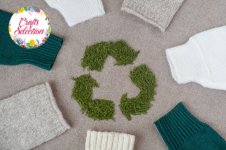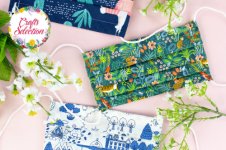- Thread starter
- #1
danielnorman
New member
Eco-friendly Sewing: A Guide for Beginners
Sewing is not just a creative outlet; it's a powerful way to achieve sustainability. Making clothes with eco-friendly sewing enables you to create thoughtful, long-lasting items that align with your ideals in a rapid fashion and overconsumption world. Custom-made items can be manufactured to your specifications, guaranteeing a perfect fit and minimizing textile waste. You can help the fashion industry become more environmentally friendly, lower your carbon footprint, and even save money by making an effort to make and repair your clothing. Here is a step-by-step manual for eco-friendly sewing for beginners, with suggestions and advice.
Want to know what other crafters think of the latest and greatest products? Visit Crafts Selection for reviews of the best sewing products. We'll help you get the inside scoop on the rave reviews of the top-rated sewing products. We also aggregate reviews from other trusted sources to get a well-rounded view of a product before you buy.
➤➤➤ Check over here: Good Product Review CraftsSelection.com
Good Product Review CraftsSelection.com

Avoid purchasing excessive amounts of cloth because doing so can result in waste. Instead, limit your purchases to items you will utilize in the coming month. Bulk purchasing could be cost-effective, but it backfires if the supplies go unused.
Whether you're a beginner or a seasoned sewer, Crafts Selection has the top sewing product comparisons you need. We'll help you make an informed decision about your next purchase.
Find More Info: CraftsSelection.com Selection of Best Craft Machines
CraftsSelection.com Selection of Best Craft Machines
You'll greatly increase the longevity of your clothing as you hone the art of mending, lowering the frequency of replacement. Additionally, you'll stay fashionable and promote sustainability by upcycling and customizing your clothes.

When pattern pieces don't have seam allowances, you can save up to 30% of fabric by folding your cloth carefully. This method saves fabric and demonstrates your dedication to sewing sustainably
✺✺✺ See Also: Best Sewing and Craft Products CraftsSelection.com
Best Sewing and Craft Products CraftsSelection.com
Conclusion
Eco-friendly sewing is a sustainable lifestyle choice, not just a pastime. You may decrease fabric waste, increase the lifespan of your apparel, and use environmentally friendly materials by implementing these tips. If you learn the craft of environmentally friendly sewing, you'll find a satisfying creative outlet and help create a more ethical and sustainable fashion business. So, take your sewing machine on a conscientious and environmentally responsible crafting trip.
Sewing is not just a creative outlet; it's a powerful way to achieve sustainability. Making clothes with eco-friendly sewing enables you to create thoughtful, long-lasting items that align with your ideals in a rapid fashion and overconsumption world. Custom-made items can be manufactured to your specifications, guaranteeing a perfect fit and minimizing textile waste. You can help the fashion industry become more environmentally friendly, lower your carbon footprint, and even save money by making an effort to make and repair your clothing. Here is a step-by-step manual for eco-friendly sewing for beginners, with suggestions and advice.
Want to know what other crafters think of the latest and greatest products? Visit Crafts Selection for reviews of the best sewing products. We'll help you get the inside scoop on the rave reviews of the top-rated sewing products. We also aggregate reviews from other trusted sources to get a well-rounded view of a product before you buy.
➤➤➤ Check over here:
- Buy Less Fabric

Avoid purchasing excessive amounts of cloth because doing so can result in waste. Instead, limit your purchases to items you will utilize in the coming month. Bulk purchasing could be cost-effective, but it backfires if the supplies go unused.
- Choose Sustainable Equipment
Whether you're a beginner or a seasoned sewer, Crafts Selection has the top sewing product comparisons you need. We'll help you make an informed decision about your next purchase.
Find More Info:
- Repair Before Replacing
You'll greatly increase the longevity of your clothing as you hone the art of mending, lowering the frequency of replacement. Additionally, you'll stay fashionable and promote sustainability by upcycling and customizing your clothes.
- Organic Fabric

- Be Mindful of Fabric Cutting
When pattern pieces don't have seam allowances, you can save up to 30% of fabric by folding your cloth carefully. This method saves fabric and demonstrates your dedication to sewing sustainably
✺✺✺ See Also:
Conclusion
Eco-friendly sewing is a sustainable lifestyle choice, not just a pastime. You may decrease fabric waste, increase the lifespan of your apparel, and use environmentally friendly materials by implementing these tips. If you learn the craft of environmentally friendly sewing, you'll find a satisfying creative outlet and help create a more ethical and sustainable fashion business. So, take your sewing machine on a conscientious and environmentally responsible crafting trip.
Last edited:
